The importance of churchyards
 | Churchyards support a great diversity of lichens, and are especially important in areas where there are few natural rock outcrops.
They also provide an excellent environment for the study of lichen biology and colonisation, and are convenient and accessible places to learn identification skills. |
Churchyard habitats
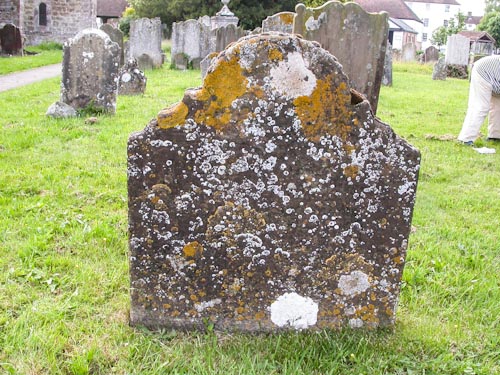
Provided there is sufficient light and moisture, lichens are able to colonise surfaces mostly unsuitable for flowering plants.
The geology is often varied, with limestone, sandstone, ironstone, marble, brick, mortar, slate and granite, each having their distinctive lichen communities. Different rock types may be found in the walls of the church, the boundary wall, and the various gravestones and monuments, and to add to that these stone surfaces vary from rough to smooth, shaded to exposed, damp to dry, horizontal to vertical, providing a multitude of micro-niches for lichens and bryophytes. The lichens on the shaded north side and the sunny south side of the church are, for example, markedly different.
Further micro-habitats are provided by recessed lettering, soil crevices in boundary walls, and the granite chippings within a kerbed grave. There may even be different lichens where the stone is affected by lead run-off from windows, or copper from a lightning conductor.In addition, lichens are to be found on well-established trees, wooden structures such as seats and fences, grassy areas, pathways and even rubber dustbin lids!
Each of these mirco-niches will be ideal for some species but not at all suitable for others, and that leads to a great variety of lichens within the churchyard.
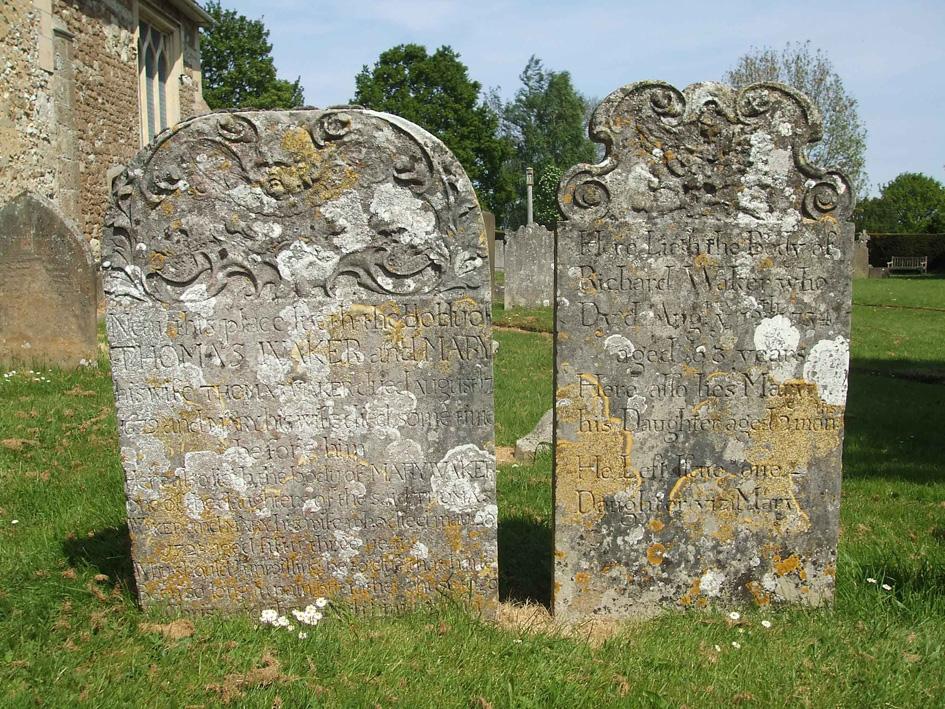
Limestone headstones with golden and grey crustose lichens
Some species grow very slowly, sometimes less than half a millimetre a year, while others grow more rapidly. Many are long-lived, and individual lichens may well be almost as old as the gravestones upon which they live. The ancient stonework of churches and churchyards, when undisturbed and unpolluted by chemical sprays, thus provides a sanctuary for them.
Species lists can contain more than a hundred species in a single churchyard, and in Indeed, in lowland Britain churchyards are often the only habitat where many species are recorded. For example, limestone memorials are often found even in areas where the local stone is granite, and are easily distinguished by the golden circles of Caloplaca species which grow on them.
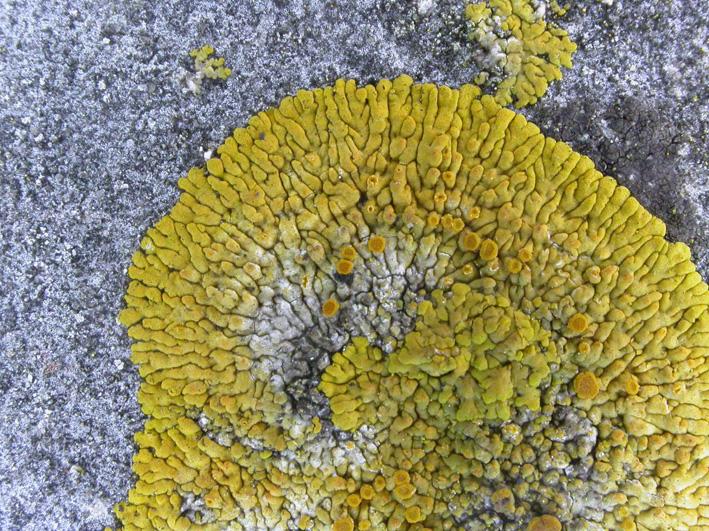
The golden crustose lichen Variospora flavescens on limestone
Some species occurring in churchyards are quite uncommon, or at least uncommon in other habitats. Churches, their memorials and surrounding walls are often the oldest man-made stone structures in the landscape. Although some lichens can colonise substrates quite quickly, with species first appearing within a few years, others colonise very slowly and it can take hundreds of years for some lichens to become established. Indeed, there are some which will only grow on other well-established lichens.

Granite Celtic cross with leafy and crustose lichens
The BLS churchyard survey
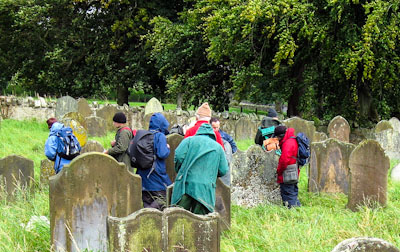 The BLS Lowland Churchyard project was instigated in the early 1990s with the initial aim of surveying at least one churchyard in each of the Ordnance Survey’s 10km squares (hectads) in lowland Britain, This was achieved as a Millennium Project but surveying continues in some areas and has extended the scope into the South-west, Wales and the Borders, and Northern England. We now have more than 550,000 records from churchyards, but there are still plenty of gaps to fill.
The BLS Lowland Churchyard project was instigated in the early 1990s with the initial aim of surveying at least one churchyard in each of the Ordnance Survey’s 10km squares (hectads) in lowland Britain, This was achieved as a Millennium Project but surveying continues in some areas and has extended the scope into the South-west, Wales and the Borders, and Northern England. We now have more than 550,000 records from churchyards, but there are still plenty of gaps to fill.
The environment of Britain is changing in complex ways that vary from one area to another, so it is important that we continue this survey by recording new sites and by revisiting those that were last surveyed some time ago. Some have changed little since the 1980-90s or have increased in diversity as air quality has improved, but in others changing environmental conditions have led to considerable losses from the lichen flora. The increasing shade from maturing trees, the modern practice of leaving parts of churchyards unmanaged as "wildlife" areas , and the increase in atmospheric nitrogen pollutants, ammonia and NOX, in some areas, are all factors in this. Resurvey of churchyards will provide valuable data on how widespread these issues are and their effects on different lichen species.
Reasons for conserving lichens
Lichen colonisation is a natural consequence of any surface that is left exposed to the environment for a long time. Lichens indicate clean air and are regarded by many as decorative rather than disfiguring. Lichens are very sensitive to environmental change and our lichen flora is constantly under threat from numerous human activities. Without lichens we would have a much poorer understanding of the health of our environment for humans as well as for wildlife.
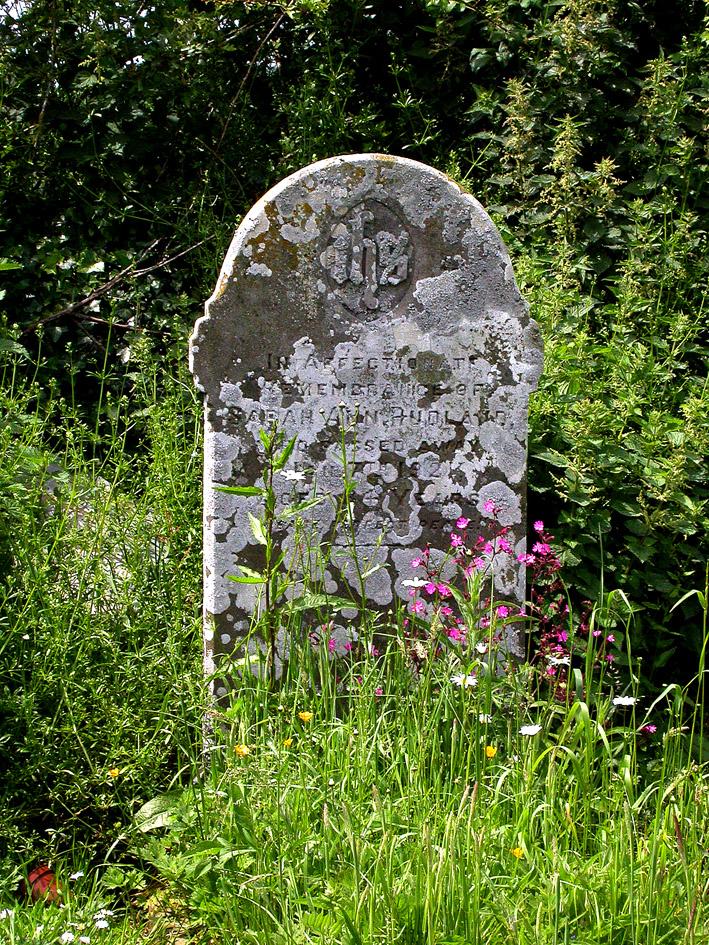
Grey and white crustose lichens on a sandstone headstoneChurchyard management
Churchyard management for lichens
The survival of this wonderful lichen diversity is very much dependent on how the churchyards are looked after. Abandoned churchyards become overgrown and the lichens wither in resulting shade. The gravestones may be cleaned and the lichens scrubbed off as the stone surface is worn away. Saddest of all is the laying flat of vertical memorial stones that have been deemed unsafe, leaving the churchyard looking like a decimated army on a war-torn battlefield.
The British Lichen Society, mindful of the needs of managing churchyards safely and economically, is keen for the lichens to be considered. We are able to offer advice about:
- whether the lichen flora in a churchyard is of particular value
- how the churchyard can be managed for the conservation of its lichens.
We can also help by participating in the decision-making process about the management of churchyards, so that the best solution can be found for lichen conservation.
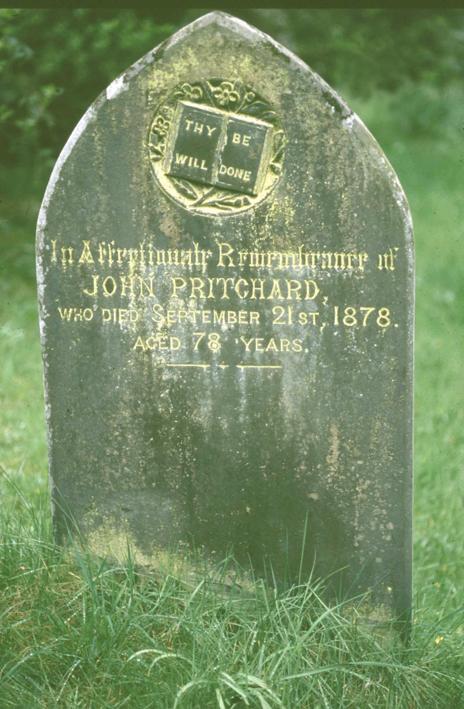
The lichen Psilolechia lucida picks out the letters on a slate headstone
Lichens can present particular problems for churchyard management, for example:
- fundamental knowledge of lichens, and of valuable species in the churchyard, may be lacking
- parishioners may be puzzled about the need to conserve lichens in a churchyard which they see as having an entirely different purpose
- in places, the lichen cover may not be regarded as compatible with the purpose of particular stone work which the lichens have colonised
- safety-test surveys may recommend that certain memorial stones are laid down or made safe
- repairs to walls, roofs, monuments or other structures may disturb surfaces which have a valuable lichen flora.
In all these cases, please feel free to get in touch with us. We may already know of important lichens and where they are in the churchyard, or we may be able to carry out a survey to see if the lichen flora is of conservation value. A lichenologist could come and meet with parishioners to talk about lichens and explain about their conservation in non-technical language. We can also advise on suitable methods of lichen removal where it is absolutely necessary, and help to identify headstones that should be repaired or made safe to protect the lichens on them rather than laying them down.
More information
For further information on churchyard management and the conservation of churchyard lichens download the “Green Leaflet” on Churchyard Lichens and brief guidelines on the management of churchyards for lichens.
nyone wishing to get involved in the churchyard lichen survey should start by getting in touch with the local contact for their area, it is always a good idea to visit a few churchyards with someone more experienced before setting out on your own. Various resources are available on this website to support churchyard surveys, including a Photo Guide to Common Churchyard Lichens, a guide to Lichen Communities of British Churchyards, originally produced by Tom Chester but since updated, and an Analysis of the churchyard records in the BLS database.
Once you get into recording churchyard lichens please use the BLS spreadsheet to send your records in to the database. It helps if you can use the substrate and scale habitat codes to provide more information about species of interest, these are listed in the spreadsheet and a useful guide to the position codes can be downloaded below.
Links to all these resources are at the bottom of this page.
If you want to find out what is already known about the lichens of a particular churchyard, please email records@britishlichensociety.org.uk and we will send you a spreadsheet and summary of the records we hold.